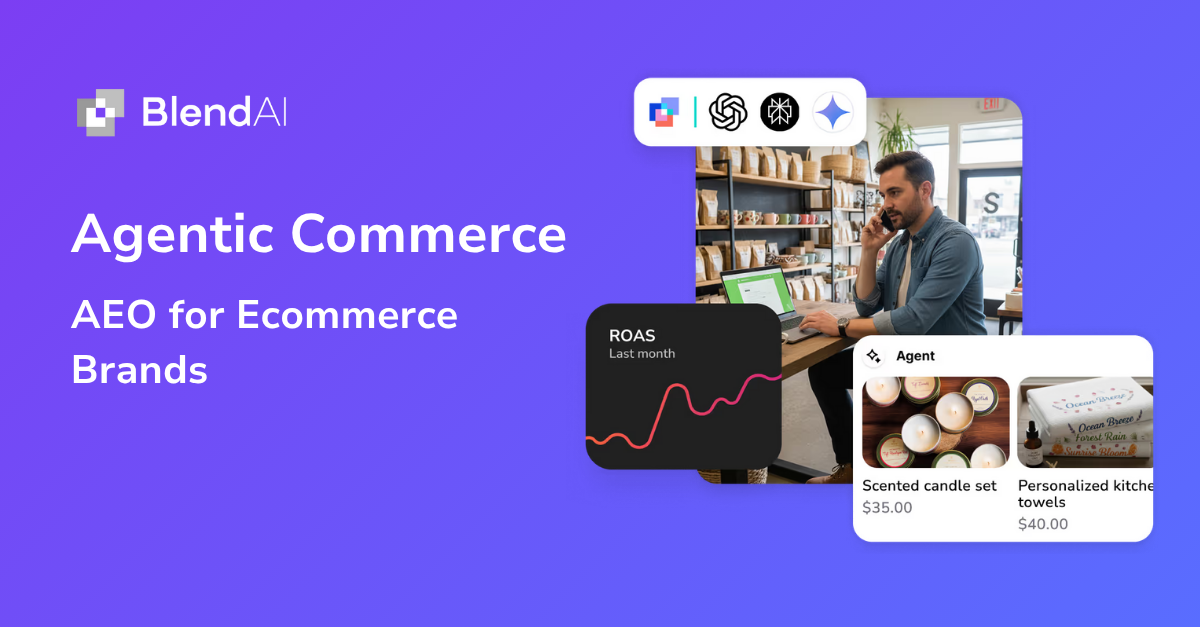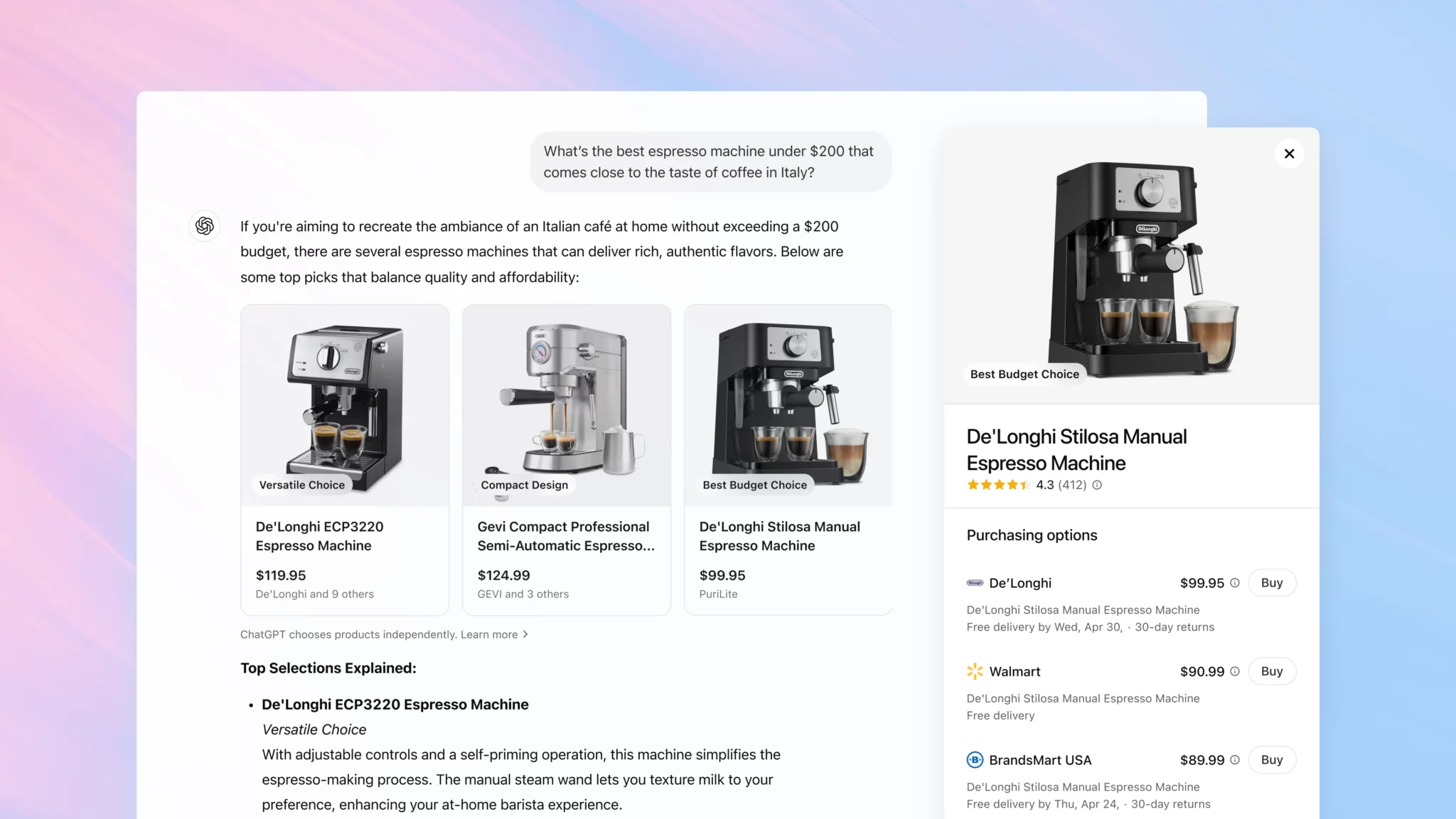06 Nov 2025
・
eCommerce
・
5 min
Agentic Commerce: AEO for Ecommerce Brands

In 2025, the way people shop online is quietly but fundamentally changing. Shoppers aren’t scrolling through pages of search results anymore - they’re asking questions. “What’s the best moisturizer for sensitive skin?” “Find me running shoes under $150 for flat feet.” “Which air fryer is easiest to clean?” These are no longer keyword searches. They’re conversations powered by AI shopping assistants and retail artificial intelligence.
The answers aren’t coming from traditional search engines anymore - they’re coming from AI shopping platforms like ChatGPT, Gemini, and Perplexity. These tools don’t just point people to websites; they recommend products, summarize reviews, and even help complete purchases. This new era is called agentic commerce - a world where AI for shopping acts as personal shopper, curator, and checkout assistant all in one.
What Agentic Commerce Means for eCommerce Brands
In agentic commerce, visibility works differently. When someone asks an AI a shopping-related question, the model doesn’t show ten blue links filled with keywords, it picks one or two products it deems most relevant, trustworthy, and available.
That means your store either appears in that small AI-generated response or it doesn’t appear at all.
The difference comes down to how well shopping AI systems can understand, trust, and interpret your brand’s data. These models don’t just scrape websites. They analyze structured data, product feeds, reviews, and schema markup to figure out what your products are, who they’re for, and how credible your brand seems. They reward clarity and consistency. If your data is incomplete, your reviews are hidden, or your content feels vague, you’ll disappear from AI in online shopping results altogether.

From SEO to AEO
For years, SEO (Search Engine Optimization) has been the foundation of ecommerce visibility. The goal was simple: rank high in search results and get the click.
But as AI in shopping reshapes how people discover and buy, the rules are changing. Visibility is no longer about ranking on Google, it’s about being selected by Google Shopping AI or an AI shopping assistant as the most credible answer.
That’s where AEO (Answer Engine Optimization) comes in. AEO is the evolution of SEO for the AI era. Instead of optimizing for search algorithms, you’re optimizing for artificial intelligence in online shopping systems that read, summarize, and recommend. It’s about making your content machine-readable, semantically clear, and credible enough that AI shops and language models quote your brand when asked a question.
If SEO helps you get found, AEO helps you get featured.
Why This Shift Matters
The shift from search to conversation changes everything about ecommerce marketing. Discovery, consideration, and purchase are now happening in a single step.
In the past, a customer might search, browse, compare, and then buy. Now, they can ask ChatGPT eCommerce a question and get an instant product recommendation, often buying directly from the chat. This is AI shopping in action.
That creates both risk and opportunity. The risk is clear: if your brand isn’t part of these AI shopping ecosystems, you’re invisible. The opportunity is equally clear: if your data is structured, your reviews are visible, and your content answers real questions, you can dominate this new channel before it gets crowded.
How to Prepare for Agentic Commerce
Preparing for agentic commerce means making your brand legible to machines. The foundation is clarity, structure, and trust.
Start with your product data. Every attribute counts: name, price, material, category, audience, and use case. Avoid cryptic product titles or abbreviations. Instead of “RSX 500 V2,” say “lightweight running shoe for flat feet.” This is exactly the kind of phrasing AI for shopping systems like Shopify ChatGPT or ChatGPT Shop can understand and recommend.
Next, add structured data through schema markup. Schema tells AI exactly what’s on your site: what’s a product, what’s a review, what’s a question and answer. It’s like labeling every part of your store in a language that AI in online shopping can easily interpret. Use Product, Review, FAQPage, and QAPage schema consistently.
Then focus on trust signals. Retail artificial intelligence systems evaluate brand credibility before making recommendations. Verified reviews, transparent return policies, consistent brand information, and clear shipping details all matter. These aren’t just helpful for customers, they’re signals of reliability for AI agents.
Finally, make your content conversational. A shopping AI understands natural phrasing better than keyword stuffing. Write product descriptions that answer real buyer questions. Use human, helpful tone. The closer your content sounds to how people ask questions, the better it performs in AI-powered shopping results.
The Role of Data Accuracy
One of the biggest hidden factors in AI-driven shopping is data accuracy. These systems pull from multiple sources: your website, your feeds, your reviews, and external listings. If your information doesn’t match across them, you lose trust.
Something as small as mismatched pricing or out-of-date stock levels can cause AI to skip your listing entirely. Clean data is now a key part of brand authority.
Keeping your product feeds synced across platforms like Google Shopping AI, Meta, and Shopify isn’t just a best practice, it’s a competitive advantage. Every price change, review, or inventory update should flow seamlessly through your entire ecosystem. This ensures you remain visible wherever AI shopping tools are gathering data.
How to Measure AI Traffic
You might not see big traffic spikes at first, but you’ll start noticing subtle signals, more branded searches, stronger click-through on your ads, or higher conversion rates.
That’s because AI visibility often starts as mentions without clicks. You might be cited as a recommended brand in ChatGPT eCommerce, Gemini, or Bing Copilot results, even if users don’t click right away. Over time, that awarene converts.
If you’re tracking this, tools that measure AI Overview appearances or agentic commerce visibility will help. You can also spot AI influence in UTM tags in GA4 or your Shopify Dashboard.
Common Mistakes to Avoid
Many brands assume their SEO strategy automatically covers AI shopping visibility but that’s not true. Traditional SEO focuses on keyword rankings, not how data is presented to AI systems.
Common mistakes include incomplete schema, robotic-sounding copy, and ignoring product detail pages. PDPs are your strongest asset in agentic commerce because they contain the structured data, reviews, and FAQs AI models depend on.
Another issue is neglecting diverse data sources. AI in shopping doesn’t just learn from your site, it pulls from social proof, Reddit discussions, YouTube videos, and UGC. The more authentic mentions your brand has across platforms, the more credible it appears to shopping AI models.
And finally, treating AEO as a one-time task is a major mistake. AI systems evolve fast. Regular audits, schema updates, and fresh Q&A content are the only way to maintain visibility in artificial intelligence online shopping environments.
Why Early Adoption Matters
Agentic commerce is already reshaping the ecommerce landscape. Google’s AI Overview, OpenAI’s shopping integrations, and Shopify ChatGPT partnerships are proof that the shift is underway.
Brands that prepare now will dominate AI-driven shopping results before competition floods in. Just like the early days of SEO, the first movers in AI-powered commerce will capture lasting visibility and trust.
By 2026, a large share of product discovery will happen inside AI shopping assistants and chat-based environments. That means the way you structure and optimize your data today determines how discoverable you’ll be tomorrow.
How to Optimize Your eCommerce Store with AI
You can use Blend AI to automatically optimize your store and product data for AI in online shopping. Blend structures and enriches your catalog so it’s instantly readable by systems like ChatGPT, Gemini, and Google Shopping AI.
It’s plug-and-play so no manual setup, no developer work. Blend gives you smarter, AI-optimized visibility across every channel, connecting your paid, organic, and agentic commerce performance in one ecosystem.
If you want to stay visible in the age of AI shopping, Shopify ChatGPT, and retail artificial intelligence, now’s the time to make your brand AI-ready with Blend AI. Because in a world where AI does the recommending, the brands that win are the ones that machines, and shoppers, trust most.
